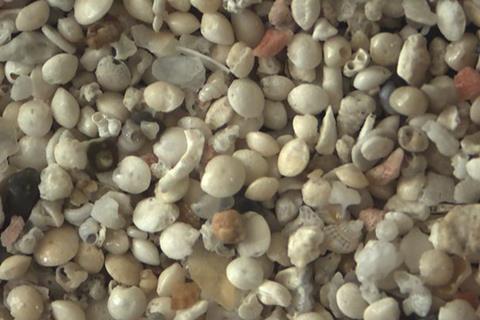Pamela Hallock, a biogeological oceanographer and distinguished university professor at the University of South Florida College of Marine Science, typically finds little comfort in climate change.

Hallock has spent her career studying the ocean. She leads USF’s Reef Indicators Lab and is no stranger to the impacts of human activities on marine environments.
READ MORE: Marine bacteria team up to produce a vital vitamin
READ MORE: What microscopic fossilized shells tell us about ancient climate change
Still, she couldn’t help but notice a bright spot in the results of her recent paper on a species of single-celled organisms called foraminifera (forams), published in the Journal of Foraminiferal Research.
Marine organism builidng beaches
“These forams have been increasing in numbers in suitable environments,” Hallock said. “Now they’re so prolific that they’re becoming an economic resource in regions with warm waters and high alkalinity because they’re building beaches.”
The foram species in question, Amphistegina lobifera, found favorable conditions in the warm, nutrient-poor waters of the Mediterranean Sea after traveling north through the Suez Canal 60-80 years ago. A. lobifera populations have since proliferated in the eastern Mediterranean and spread westward, raising concerns about its invasive potential in the region.
Despite these concerns, A. lobifera may be boon for tourism in countries like Turkey, Hallock said. Their calcium carbonate skeletons make excellent beach sand. Shorelines once covered in jagged volcanic and limestone rock have accumulated a half meter or more of sand comprised of dead foram skeletons and other shells.
“The rate at which these forams are building beaches in the region is comparable to the rate of sea level rise,” Hallock said.
Climate change beneficial for A. lobifera
There’s reason to believe A. lobifera may continue to flourish in a warming world replete with atmospheric CO2. The genus Amphistegina emerged on Earth during a period of higher atmospheric CO2 concentrations, Hallock noted in her paper, and warm waters with elevated alkalinity increase their rates of metabolism and shell formation.
While A. lobifera may currently be considered invasive in the Mediterranean Sea, its presence in the region is really a return to ancestral waters.
“These are a kind of critter that previously inhabited the region,” she said. “Now, through our influence on the environment, we’re making the habitat once again suitable for them.”
The recent study offers a unique perspective about the impacts of humans on marine environments, and vice versa.
As Hallock and her co-authors state in the study, “Might this return of prolific shallow-water carbonate production ultimately prove at least locally beneficial as climate change progresses?”
KEY TAKEAWAYS:
- A species of single-celled organisms called foraminifera (forams) is increasing in warm, alkaline waters of the eastern Mediterranean, building beaches with their calcium carbonate skeletons.
- In regions like Turke, forams are creating sandy shorelines where there used to be rocky terrain, benefiting tourism.
- Forams thrive in warm waters with high CO2, suggesting they might continue growing as climate change accelerates.
- This species of foram, once native to the Mediterranean, is returning as human activities make their preferred environment suitable again.







No comments yet